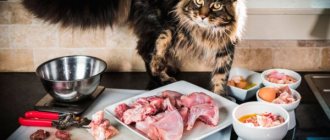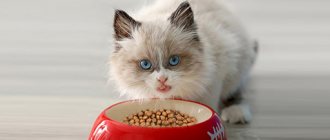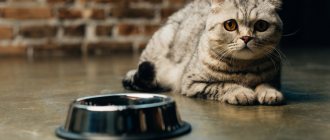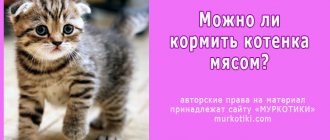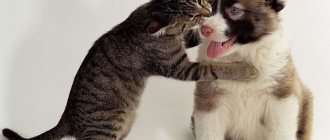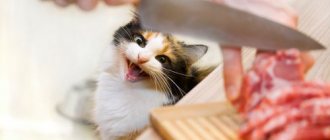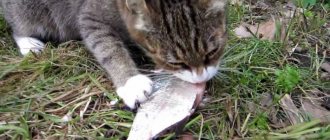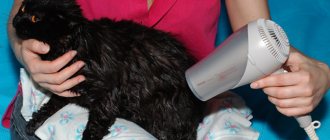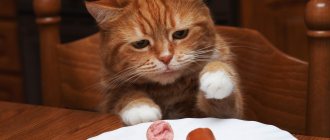Domestic cats are one of the most common companion animals. By type of nutrition, the cat is a strict (obligate) predator. This means that the cat prefers to eat prey that it has killed itself. We offer you general recommendations for feeding cats. A cat's needs will depend on its breed, size, age, energy level and health problems. Consult your veterinarian about how many calories your cat should consume each day and how to structure her diet.
- Cat nutrition features
- How a cat feeds kittens
- What to feed a cat: what natural products can be given to a cat
- Is it possible to give a cat fish, pork, milk, raw liver, bones, smoked meats?
- What other foods should you not give to your cat?
- How and how much to feed a cat
- How to give your cat dry food
- What is not recommended to do when feeding cats dry food
Main mistakes when choosing a diet
One way or another, each owner chooses what he will feed his pet, but how to feed cats and cats correctly, what to focus on when choosing a diet?
The Internet, advice from friends, advertising are not the most reliable sources, and here you can fall into some kind of “traps”. For example, there is a popular misconception that the most cat-like food is fish. Yes, many cats love fish very much, but this product should not be abused, especially if the cat has a tendency to urolithiasis. Often, owners are guided by the tastes of the cat itself, without delving into the essence of the issue; such indulgence of the pet’s preferences can lead to serious consequences. Information from the manufacturer, when it comes to ready-made food, is partly of an advertising nature - this is the law of the market, so you should not blindly trust advertising either. You can contact a specialist, but when it comes to feeding a cat correctly, a veterinarian’s advice may not always be a panacea.
Firstly, there are not many veterinary nutritionists in Russia, and they cannot be found in every city. And sometimes even the most experienced veterinarian, who can operate on a cat with his eyes closed, will not be able to give complete advice on how to feed this cat. Secondly, veterinarians often collaborate with manufacturers and recommend their ready-made food because they receive financial benefits from it, and not at all because this particular product is suitable for the pet.
So, in order to approach feeding a pet responsibly, we must have an understanding of the cat’s digestion and physiology, and also learn to understand the composition, pros and cons of different types of food.
Choosing a bowl for feeding a kitty
When choosing bowls from which it is convenient to feed cats, preference is given to high-quality ones intended for food products. They can also eat from dishes made for people, but it is better to purchase a special one that is designed and convenient for a cat.
Bowls can be made of plastic, metal or ceramic. Plastic is the cheapest option, but it has many disadvantages. The material is porous, it is difficult to maintain hygiene, and some pets are allergic to it.
It is healthier to feed your cat from metal bowls. The dishes are durable, easy to clean, and animals rarely turn them over. The material does not accumulate static electricity, which is unpleasant for kitties. To prevent the metal from oxidizing, choose stainless steel bowls.
The most versatile material is ceramics. The dishes are hygienic, there is no noise like metal ones, but they break easily and are expensive. When purchasing, you need to make sure that the glaze does not contain lead.
Owners often feed cats from double bowls (for food and water). This option is not considered convenient - it is difficult to keep the water clean when there is food in the next compartment. Water is poured into a separate bowl or an automatic drinker with a filter is purchased.
Pets with eating disorders are provided with special dishes for slow feeding. These should be eaten by cats who swallow the food too quickly and develop vomiting.
How to feed cats and cats correctly?
Domestication has had no effect on the cat's digestion and enzyme system, and it still requires animal food. It is dishonest for the owner to neglect this, because the pet is completely dependent on the person in this matter. Therefore, before you have a furry friend at home, you need to figure out how to properly feed an adult cat, and a kitten too, based on the main thesis: they get all the substances necessary for life from animal protein and fat, which means that they should form the basis of their diet.
Vegetable protein, the source of which is cereals, which some manufacturers love to saturate their products with, is incomplete for cats, since it does not contain all the amino acids they need, including essential ones, which enter the body only with food. For example, plant protein completely lacks taurine, a chronic deficiency of which causes dilated cardiomyopathy (heart disease), and sooner or later leads to blindness and other pathologies, and then the death of the animal.
Animal fat contains essential fatty acids, such as arachidonic acid, which is involved in many body processes, and essential Omega-3 fatty acids.
Menu examples
Fish menu
Morning feeding: quail eggs (by weight, no more than 3) with 1-2 tsp. cottage cheese.
Snack: fermented milk products, 30-50 ml.
Evening feeding: 100-120 g of boiled fish with grated vegetables (20-30 g) and ½ tsp. oils
Meat menu
Morning feeding: milk porridge (any cereal) or boiled in water with the addition of kefir or cottage cheese (the consistency should not be too thick).
Snack: treats or pieces of dried liver (10 g)
Evening feeding: 110-130 g of meat with vegetables (20-30 g) and ½ tsp. oils
Clean meat is not the answer
It would seem simple to provide a cat with all this, because now a wide range of fresh meat is available in stores and markets. But it's not that simple. In nature, a cat eats its prey entirely: with bones, internal organs, including the contents of the stomach, connective tissues, blood and fur. With all this, the animal receives not only proteins and fats, but also a full range of vitamins, macro- and microelements, fiber and other important substances. In the store, you will only buy muscle meat, possibly with fat, as well as a limited set of offal.
From this, if you understand the issue, you can create a complete diet by adding sources of fiber, Omega-3 fatty acids (best in the form of fish oil, as its richest source), and a vitamin and mineral complex. However, all this is troublesome and quite expensive, which is why owners today so often choose ready-made industrial diets in the form of canned food or dry food, and there is nothing wrong with this if you understand the main thing - all these products must meet the same requirements as natural diets, that is, to best meet the physiological needs of the cat.
When looking for such a diet, you can use the “Feed your pet correctly” service, here you will find ratings and detailed descriptions of many dry and wet foods, compiled by specialists according to certain criteria. You can also read separately about each of the more than a thousand ingredients used in animal feed in our database.
Separately, it is worth mentioning cases when a standard diet is not suitable for a pet. In particular, cats suffering from kidney and liver diseases, urolithiasis, obesity and other problems require a special veterinary diet. In this case, when deciding how to properly feed your cat, only a veterinarian can provide professional assistance. Moreover, the choice of diet required by the animal is made only after an examination and a series of tests.
In what cases is industrial food better than natural food?
There are several points when it is better to replace natural products with industrial food:
- The owner is often not at home . Natural ingredients spoil quickly, especially in hot weather. If the breeder has an automatic feeder, it is necessary to use only industrial feed. This option is suitable for those people whose work requires travel.
- A person has a spayed or neutered cat. Manufacturers have taken care of pets by creating a specialized product that contains all the necessary substances and does not contribute to excess weight gain. At home, it is important to carefully select ingredients without disrupting metabolism. The amount of carbohydrates is reduced by 30%.
- The cat is sick with something. For animals with diabetes, kidney disease or urolithiasis, special lines of food have been developed taking into account the need for vitamins and minerals. It is difficult to maintain such a diet at home.
For any illness, it is important to consult a veterinarian; he will prescribe a diet.
When and how much food to give?
It is enough to feed an adult healthy cat twice a day, it is better to do this at approximately the same time in the morning and evening. When determining the daily food intake, you should not focus on the cat’s appetite: all cats are different, and if one is happy to eat almost around the clock, then feeding another, on the contrary, is a big problem. At the same time, the needs for calories and nutrients for both are on average approximately the same, although to some extent they depend on certain factors.
On average, the daily food intake for natural feeding should be 5% of the weight of the cat itself, if we are talking about an adult animal. If we are talking about dry food, then manufacturers always place information on the packaging on how to calculate the food depending on the weight of the animal. For a more accurate calculation, the pet must be weighed regularly.
Drinking regime
When asking how to properly feed an adult cat, you must remember that in addition to food, he must also receive a sufficient amount of liquid. Why do cats need water? The species of small feline predators, the distant ancestors of today's domestic cats, was evolutionarily formed in desert areas under conditions of severe lack of moisture; their body conserves liquid, so the urine of cats is naturally highly concentrated.
The problem is aggravated by the fact that they have a reduced sense of thirst - probably all owners of tailed friends have noticed that their pets drink a little. That is why fresh water should always be available to the animal. However, do not be surprised if the cat does not drink water from a bowl located next to the place where it eats. In the wild, representatives of the cat family do not drink water near the killed victim; they prefer to look for clean sources of drinking water in the distance. Many pets still have this instinct. It is best to place containers with water in different parts of the apartment - sooner or later the cat will find one or more places that are comfortable for itself.
Some cats prefer running water; in such cases, a special fountain that provides constant circulation and purification of water can be a solution. Some homeowners leave a small stream in the sink, but we do not recommend following this example unless the tap has a built-in filter. The fact is that tap water contains a lot of salts and impurities, which can lead to ICD.
The average daily fluid intake per 1 kg of animal should be 30 ml of water, but you need to take into account what kind of food the cat receives. With a dry diet, the amount of water should be 2-3 times greater than the amount of food eaten; when feeding with natural food or wet food, the need for drinking water is reduced. If your cat refuses to drink water, despite all your efforts, you will have to exclude dry food and try to compensate for the cat’s body’s need for fluid with wet food.
What to feed a kitten to keep it healthy?
Newborn kitties are breastfed. Ideally, they stay with their mother for up to two months. From four weeks, babies begin to be fed, adhering to several principles:
- balanced diet;
- freshly prepared food;
- correspondence of the serving size and frequency of feeding to the age of the kisu;
- food at room temperature;
- constant access to clean water.
The best food for a cat is natural. You can feed him lean meat, rice or buckwheat porridge, chicken or beef liver, offal, boiled vegetables, eggs, cottage cheese and cheese.
When feeding dry granules, you should choose the brands “Royal Canin”, “Hills”, “Iams”. Before offering the granules to the kisa, they are soaked in broth, kefir or water.
As a vitamin supplement, it is suggested to eat “grass” - greens of sprouted oats or wheat.
conclusions
So, the health and longevity of a cat depends on a properly selected balanced diet. The basis for determining how to properly feed an adult cat is an understanding of its individual characteristics and the characteristics of its physiology as a biological species. Any cat, first of all, needs products of animal origin, supplemented with a vitamin and mineral premix. In general, any owner of a tailed friend is able to independently choose the right diet for their pet, however, in some cases, animals require a special diet, which can only be prescribed by a specialist.
The nuances of cat meals
The ancestors of cats are savages and predators, this should not be forgotten. Even the cutest big-eyed sissy cannot resist hunting a bird or small rodent. A cat's jaws are designed to easily tear prey to pieces. But the kitty does not have chewing teeth, so it is forced to swallow torn pieces of meat whole.
It is not at all necessary to give cats food with the expectation that the pet will tear it with its teeth. Whiskers easily eat food finely cut into pieces, as well as mushy portions and pates. Moreover, cats do not distinguish shades of taste well, but they are well versed in smells. A cat will never eat sour food or spoiled fish. Don't be afraid that the kitty will get tired of the monotonous diet. The main thing is that the food is fresh and contains healthy vitamins.
Sterilized pets need an individual diet - hormonal levels and body needs change after surgery. Kittens and pregnant/lactating cats must also eat a special menu.
